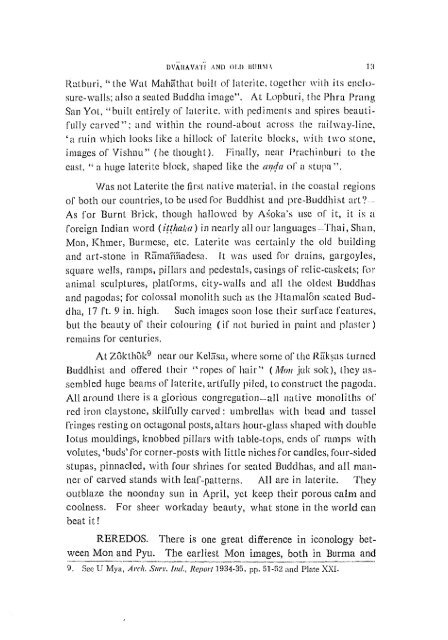The Journal of the Siam Society Vol. LIII, Part 1-2, 1965 - Khamkoo
The Journal of the Siam Society Vol. LIII, Part 1-2, 1965 - Khamkoo
The Journal of the Siam Society Vol. LIII, Part 1-2, 1965 - Khamkoo
You also want an ePaper? Increase the reach of your titles
YUMPU automatically turns print PDFs into web optimized ePapers that Google loves.
IlVAHAVATI AND OJ.IJ llllll\1\<br />
Ratburi, "<strong>the</strong> Wut Mahathut built <strong>of</strong> laterite, toge<strong>the</strong>r with its enclosure-walls;<br />
also a seated Buddha image". At Lopburi, <strong>the</strong> Phra Prang<br />
San Yot, "built entirely <strong>of</strong> laterite. with pediments and spires beautifully<br />
carved"; and within <strong>the</strong> round-about across <strong>the</strong> railway-line,<br />
'a ruin which looks like a hillock <strong>of</strong> laterite blocks, with two stone,<br />
images <strong>of</strong>' Vishnu" (he thought).<br />
Finally, ncar Prachinburi to <strong>the</strong><br />
cast, " a huge laterite block, shaped like <strong>the</strong> m_I(la or a stupa ".<br />
Was not Laterite <strong>the</strong> first native material. in <strong>the</strong> coastal regions<br />
<strong>of</strong> both our countries, to be used for Buddhist and pre-Buddhist art'!<br />
As for Burnt Brick, though hallowed by A~oka's<br />
usc <strong>of</strong> it, it is a<br />
foreign Indian word ( i!(haka) in nearly all our languages -Thai, Shan,<br />
Mon, Khmer, Burmese, etc. Laterite was certainly <strong>the</strong> old building<br />
and art-stone in Ramannadesa.<br />
It was used for drains, gargoyles,<br />
square wells, ramps, pillars and pedestals, casings <strong>of</strong> relic-caskets; for<br />
animal sculptures, platforms, city-walls and all <strong>the</strong> oldest Buddhas<br />
and pagodas; for colossal monolith such as <strong>the</strong> Htamal6n seated Buddha,<br />
17 ft. 9 in. high. Such images soon lose <strong>the</strong>ir surface features,<br />
but <strong>the</strong> beauty ol' <strong>the</strong>ir colouring (if not buried in paint unci plaster)<br />
remains for centuries.<br />
At Zolcthok 9 ncar our Keli:'isa, where some or <strong>the</strong> Rulqas turned<br />
Buddhist and <strong>of</strong>fered <strong>the</strong>ir "ropes <strong>of</strong> hair'' ( Mrm juk sok), <strong>the</strong>y ussembled<br />
huge beams ol' laterite, artfully piled, to construct <strong>the</strong> pagoda.<br />
All around <strong>the</strong>re is a glorious congregation---all native monoliths or<br />
reel iron claystone, skilfully carved: umbrellas with bead and tassel<br />
fringes resting on octagonal posts, altars hour-glass shaped with double<br />
lotus mouldings, knobbed pillars with table-tops, ends or ramps with<br />
volutes, 'buds' for corner-posts with little niches for candles, four-sided<br />
stupas, pinnaclcd, with four shrines for seated Buddhas, and all manncr<br />
<strong>of</strong> carved stands with leaf-patterns. All arc in laterite. <strong>The</strong>y<br />
outblaze <strong>the</strong> noonday sun in April, yet keep <strong>the</strong>ir porous calm and<br />
coolness. For sheer workaday beauty, what stone in <strong>the</strong> world can<br />
beat it!<br />
REREDOS.<br />
<strong>The</strong>re is one great difference in iconology between<br />
Mon and Pyu.<br />
<strong>The</strong> earliest Mon images, both in Burma and<br />
9. Sec U Mya, Arch. Sun·. Ind., Report 1934-35, pp. 51-52 and Plate XXI.

















